#Acid rain is yesterday’s news? Sulfate in freshwaters remains a problem

“#Acid rain is yesterday’s news? Sulfate in freshwaters remains a problem”

Acid rain seems to be a thing of the past, yet sulfate continues to rise in many inland waters worldwide. Researchers led by the Leibniz Institute of Freshwater Ecology and Inland Fisheries (IGB) and the Danish University of Aarhus provide an overview of the sources of sulfate and its effects on freshwater ecosystems. They point out that the negative consequences for ecosystems and drinking water production have so far only been perceived regionally and recommend that sulfate be given greater consideration in legal environmental standards.
When fossil fuels are burned, large amounts of sulfur are oxidized and released into the atmosphere. In North America and Europe, after power plants were retrofitted with flue gas desulphurisation in the 1980s, atmospheric sulfur inputs decreased significantly—in Germany by 90 percent in the last thirty years. The danger of “acid rain” seemed to have been banished. Nevertheless, sulfate concentrations in inland waters have hardly decreased or even increased in many regions of the world in recent decades. For the researchers, this is a clear sign that other pollution sources have gained in importance.
Drainage, opencast lignite mining and artificial fertilizers are among the main causes
Dissolved sulfate is naturally formed in inland waters by mineral weathering, volcanism or the decomposition and combustion of organic matter. Human activities increase the concentrations of sulfate in water. In addition to atmospheric inputs, the drainage of wetlands, the lowering of groundwater levels for opencast lignite mining, fertilizer leaching from agricultural soils and agricultural and industrial wastewater are primarily responsible for this.
Fertilizers and pesticides surpass acid rain in man-made sulfur input
The researchers also refer to a recent study by the American University of Colorado on a previously underestimated source of sulfur—agriculture. Sulfur-containing substances are used as fertilizers, but also as fungicides, for example in viticulture. Worldwide, agricultural use accounts for about 50 percent of the sulfur discharged into the environment each year, according to the US-study. In some areas of agriculture and thus also in some regions of the world, more sulfur is now entering soils and waters than at the peak of acid rain.
Climate change exacerbates the situation
Several climate change factors are expected to lead to a significant increase in sulfate concentrations in water bodies. “Increasing heavy rainfall washes sulfurous soils and fertilizers into water bodies; larger areas of wetlands fall dry; rising sea levels increase the amount of sulfate-rich saltwater entering groundwater and rivers, which can significantly increase sulfate concentrations,” says Dr. Dominik Zak from the Danish University of Aarhus, summarizing the projections he and his co-authors have compiled in the overview study.
Negative consequences for humans and ecosystems
The River Spree in Germany is an example of rivers in which sulfate concentrations have risen as a result of opencast lignite mining. In some parts, it already exceeds the drinking water limit of 250 milligrams per liter. “This is problematic because these water bodies are used as a source of drinking water—typically via groundwater extraction and through bank filtration. Lignite mining continues to play a significant role in many regions of the world, and sulfate contamination in water bodies and drinking water is an issue everywhere. Even if we in Germany have decided to phase out lignite mining, sulfate inputs into our waters will remain with us as an environmental problem in the longer term,” predicts IGB researcher Dr. Tobias Goldhammer, one of the authors of the study.
Sulfate not only impairs drinking water quality, it also affects the material cycles of carbon, nitrogen and phosphorus. Among other things, this increases the nutrient loads in water bodies and thus the growth of plants and algae as well as the food supply for aquatic organisms. The result is a lack of oxygen in the water, which promotes the further release of phosphate from the sediment—a vicious cycle. Sulfate and its degradation products—especially sulfide—can also have a toxic effect on aquatic life.
Revitalized peatlands bind sulfur
Bioremediation using living organisms such as prokaryotes, fungi, or plants is one way to remove pollutants from ecosystems. Constructed wetlands, bioreactors and permeable reactive barriers can also reduce sulfate pollution in water bodies. Scientists have high hopes for the renaturation of peatlands: the extensive draining of wetlands has released sulfur and sulfur-containing iron compounds. The rewetting of these areas can stop the release and even store sulfur: if water enriched with sulfate then reaches these wetlands via groundwater or surface water, it is filtered there.
Sulfate is a global environmental problem
“There is a great need for action to reduce sulfate concentrations in water bodies. Since the problems associated with high sulfate inputs have so far been perceived mainly regionally, the impacts on inland waters have not yet been recognized as a globally emerging environmental problem. Thus, many countries have not defined environmental standards for it. With our study, we would like to draw attention to the problem, show the current status for reducing sulfate pollution and at the same time point out the numerous knowledge gaps that still exist,” Dominik Zak sums up.
Study finds declining sulfur levels
Citation:
Acid rain is yesterday’s news? Sulfate in freshwaters remains a problem (2021, January 28)
retrieved 28 January 2021
from https://phys.org/news/2021-01-acid-yesterday-news-sulfate-freshwaters.html
This document is subject to copyright. Apart from any fair dealing for the purpose of private study or research, no
part may be reproduced without the written permission. The content is provided for information purposes only.
If you liked the article, do not forget to share it with your friends. Follow us on Google News too, click on the star and choose us from your favorites.
For forums sites go to Forum.BuradaBiliyorum.Com
If you want to read more Like this articles, you can visit our Science category.



